The sound of the doorbell, almost exaggerated in pitch with time, is one that Martina Smith will never forget. Her husband's good friends, CHC Ireland pilots Ed Shivnen and Sid Lawrence, were at the door with difficult news.
Ciarán’s helicopter was missing.
It had been a long-time practice among helicopter search and rescue crews to nominate colleagues who would contact their next of kin in the unlikely event of something going wrong.
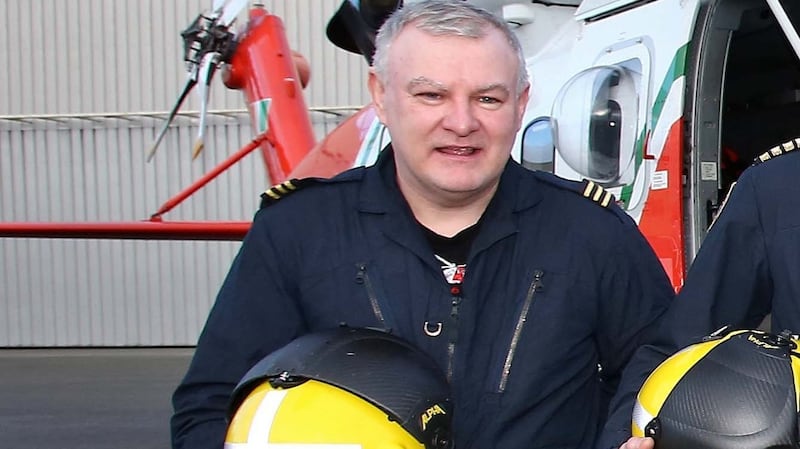
In Co Louth, Hermione Duffy, wife of Mark, was woken by a knock on the door of her home about 5.30am. On the step were Loy McParland, a former CHC pilot and close friend of her husband, and winch operator Derek Everitt. When she heard the helicopter was missing, Hermione remembered responding that this "couldn't be happening ... it's a calm night ... there is no wind".
Angela Ormsby was always up at 5.30am. On the morning of March 14th, 2017, she was in the kitchen of her home in Ballyfermot, Dublin, when she heard her son, David, moving about. He had ordered a set of training weights and was expecting them in the post that day. "So when the doorbell rang, I thought it was that delivery. I told David to go out and answer it. Paul's colleagues, Blackie [Colm Blackburn] and Christy [Mahady] were standing on the step. Christy called my name and all I heard was the word 'helicopter' and I knew something had happened. I ran up the stairs, screaming. My husband had been asleep up till then and didn't know what was going on...'
It was shortly before 6am when Dara Fitzpatrick's sister Emer was first contacted. Capt Mark Donnelly, who had been on the previous shift at Dublin, had volunteered to call out to Dara's home with aircraft maintenance engineer Eoin Murphy. Emer called her sister Niamh, who lived just four houses away.
In her own moving account, published over three years later, Niamh Fitzpatrick, a professional psychologist, remembered every small detail of those hours – as if frozen in a series of photographs. She had set her alarm for 6am. She remembered she was sleeping with her face towards the window, and she remembered Emer's first five words when she picked up the phone – "the heli has gone down".
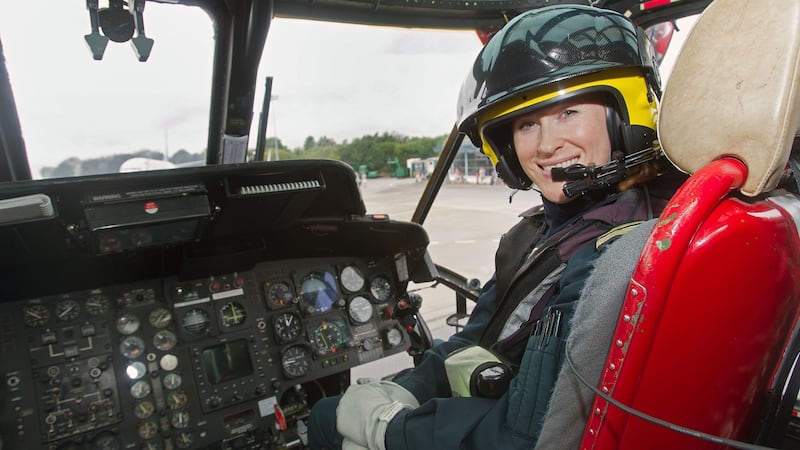
Niamh phoned her mother, Mary, and her siblings. Their father, John, had travelled to Britain the day before to attend the Cheltenham racing festival and initially couldn't be reached.
A few minutes later, Emer opened the door to Niamh; Donnelly and Murphy were standing in the kitchen. Dara’s young son, Fionn, was still fast asleep upstairs, so they spoke in whispers as the two men explained that communication had been lost with the helicopter.
During that morning, news bulletins reported that a body had been found, but did not mention any more details. Shortly before midday, the Fitzpatricks were told that representatives of CHC Ireland were on their way. They were informed that the body recovered from the water by the RNLI Achill lifeboat had been formally identified. "There was a sharp intake of breath from everyone in the room, then stifled screams, tears and complete disbelief," Niamh recorded. "I can still hear those screams even now, the anguished sounds of sorrow... "
Life as she and her family knew it had stopped just there and then.
RESCUE OPERATION
On the morning of Wednesday, March 22nd, relatives were taken out to sea on the LÉ Eithne. They included members of the Fitzpatrick family, who had travelled to Blacksod after Dara Fitzpatrick's funeral to support the continued search effort. Weather conditions were challenging, with gathering northeasterly winds. The ship was close to Blackrock Island with its relentless swell when they were informed by Commander Brian Fitzgerald that the wreckage had been found. Ciarán Smith's mother, Teresa, knew instinctively there was only one way to mark this – she led the group in prayers and reflection for all four aircrew. It was a moment those on board the ship said afterwards they would never forget.
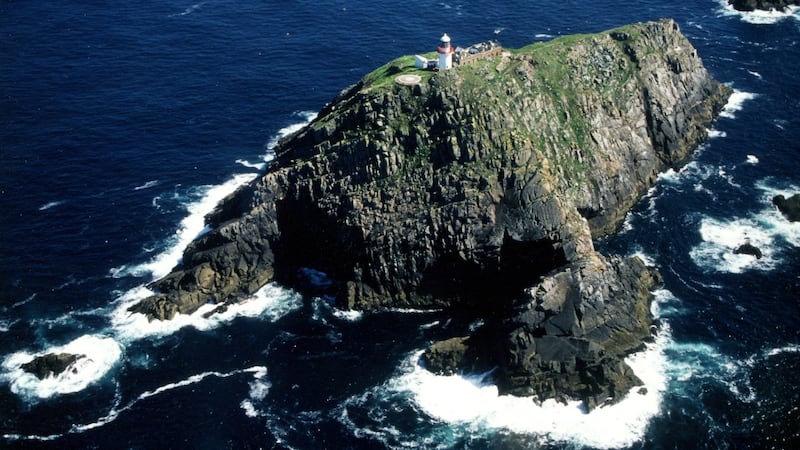
The weather was freshening, white horses galloping across the bay and a force eight gale blowing as the Eithne dropped anchor on its return to port. Naval Service RIBs transported the families back to the pier. The next stage would involve divers, and Jurgen Whyte said this stage would be handled with "great respect". He told reporters on the pier: "If we can access into the aircraft, then hopefully we will be successful in recovering the three missing crew members."
In one brief respite from torrential showers and driving wind, a rainbow lit up the sky, framing the Atlantic and Blacksod Bay.
By this stage, the course the search was taking was contributing to some tense moments. Senior Coast Guard personnel, who had been told early on that the gardaí were directing operations, were concerned that the primary focus was on retrieving the aircraft’s recording system for the investigators. A week after the crash, one senior Coast Guard officer was told that his organisation was no longer required at co-ordination meetings, as this was a “crime scene” and the Coast Guard was “under investigation”.
Inquests into the deaths of the individual crew members could be finalised, and “that would mean an awful lot to all the families”, he said. He recalled how, after Dara’s death, people “came from everywhere” to tell stories about the hundreds of lives she saved while with CHC.
In an interview with the Mail on Sunday, Ciarán Smith’s wife, Martina, said there were many inconsistencies in the AAIU report which left her with “little confidence in the process. I’m crushed and I’m heartbroken. This report leaves me very fearful that this could happen again and more families will be left without mothers and fathers.
“I’m worried that Ciarán and the crew died in vain and I have grave concerns for the safety of other search and rescue crews,” she said, referring to the “inconsistencies”. Smith said her legal team was reviewing what options she had as “Ciarán’s voice”.
Several former search and rescue pilots who spoke off the record about the report felt the full cockpit voice recorder transcript should have been published. Given that there are only two coastal lighthouses in Ireland used for search and rescue refuelling – Blacksod in Co Mayo and Castletownbere in Co Cork – it was an organisational failure and a sign of weak management if all pilots were not obliged to fly regularly to and from all four Coast Guard bases as part of training, they noted.
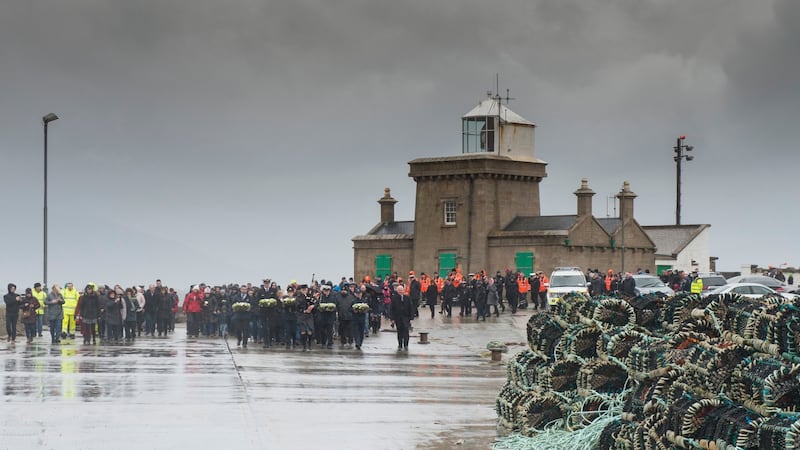
As one former search and rescue pilot pointed out: “Search and rescue is complex, dynamic and unpredictable. It is not possible, sensible or safe to write procedures for every possible scenario.” Every flight is an opportunity to train, he said, and “basic airmanship” and rules of the air apply to all aviation, including search and rescue. “If you cannot see terrain, you need to fly at least 1,000ft above it,” he noted.
It emerged that a confidential interview given by a pilot to the AAIU investigators had to be considered by the review board. In that interview, the pilot was asked about his previous experience of flying into Blacksod from Dublin and he spoke of how easy it could be to look at Blacksod on the flight management system and think there was “nothing there” because it looks like a “tiny dot”. And if one didn’t know about Blackrock Island to the west of Blacksod, and “if you missed that little red dot or if you had a waypoint painted on it, you wouldn’t see,” he said.
The pilot recalled how he would approach from a height of 500ft and would have been visual and not in instruments. He recalled how Blackrock was etched into his mind because on a training flight in daylight to Blacksod from Sligo several years previously the winch operator referred to the size of Blackrock Island and how “some day, somebody is going to run into that island” as it was “enormous”. He also recounted how there was no minimum altitude given in the route guide for APBSS or the southern route into Blacksod.
The pilot also recalled the shock he got one night when the crew was asked to try out new iPads for navigation for the first time. The pilot had reached down to get one of the “three books” or route guides in his cockpit and it wasn’t there. He then spent five minutes looking for the route guide he needed in the iPad and it wasn’t there either. He asked the rear crew if there was a route guide and a few minutes later he was handed one.
A DARK DAY
Bernard Lucas couldn't stay at home. The Co Clare farmer was well used to dropping everything to respond to a vessel in trouble off the coast. As an experienced volunteer with the Irish Coast Guard unit at Doolin, he had done so many times before. When his pager went off on September 12th, 2016, details were sketchy. A boat had capsized off Kilkee, farther north up the coast, and he was initially asked to drive up there to assist.
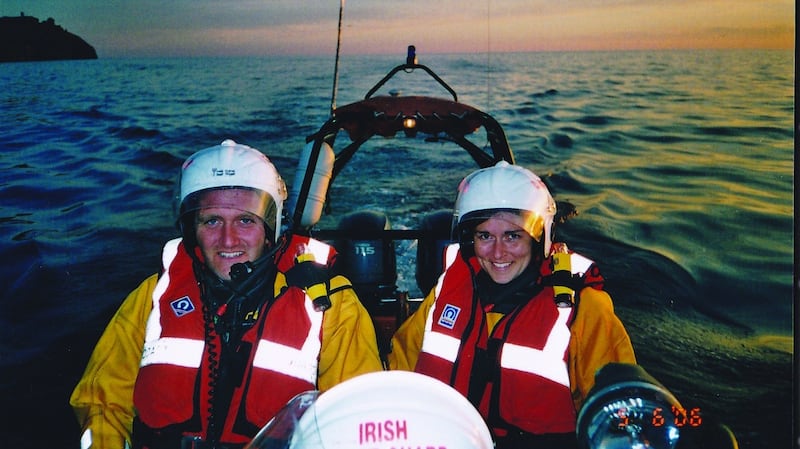
He was en route to Kilkee in his car, close to Miltown Malbay, when he was asked if he could turn around and go back to Doolin to provide crew for his unit. He did so and found officer-in-charge Mattie Shannon and colleagues waiting for him with the unit's D-class rigid inflatable boat (RIB). Bernard and fellow Doolin volunteers Conor McGrath and Davy Spillane launched, and he was on the VHF radio and close to Kilkee when advised to head directly for the pier. Bernard was puzzled and checked to confirm this over the radio. He thought they should be heading straight for the capsize.
As they approached, two gardaí were standing at the foot of the pier steps; they asked if Bernard was on board. Spillane remembered feeling a distinct sense of disquiet as his friend and colleague was escorted ashore and into a Coast Guard vehicle.
Bernard barely remembered being driven to a nearby clifftop. Only a few hours before, his wife, Caitríona (41), had left home for Kilkee to assist in a search for a missing man. She had anticipated she would be walking the shore with members of Kilkee Coast Guard. Now, just several hours later, Bernard could see paramedics working to stabilise a casualty before they were all airlifted by the Rescue 115 Shannon helicopter to hospital.
The casualty was his wife.
WHY AREN’T THEY TURNING AROUND?
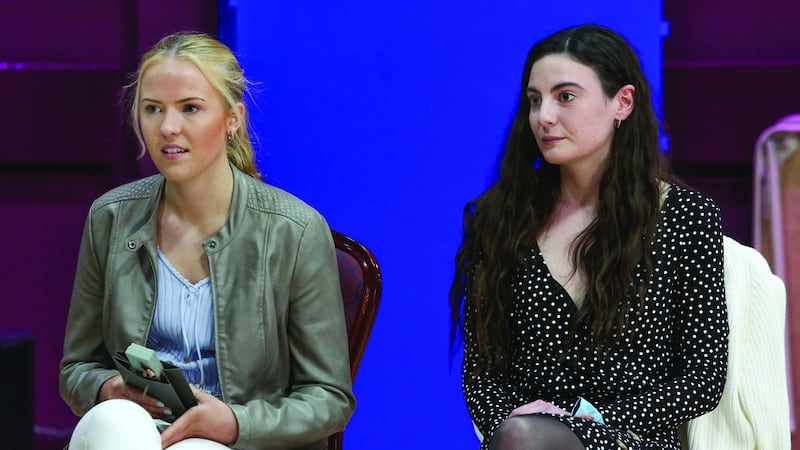
“I’m sorry, I’m sorry, I’m so sorry...” Sara reckoned she must have apologised at least 50 times as the two men drew close, threw a rope towards her, and said: “Okay, we’ll take one of ye first.”
“We were thanking them and saying we thought no one was searching and they asked us if we knew how many people were looking for us,” Ellen recalled.
They were “all over Instagram”, the Olivers told them, eliciting a mortified, “Oh no!” response from the two women.
Ellen remembered asking if it was okay to leave the boards – thinking of the pollution – but the Olivers said they would take them. As she stood up to clamber on to the 7m catamaran, her legs went from under her and she accidentally knocked her cousin into the water.
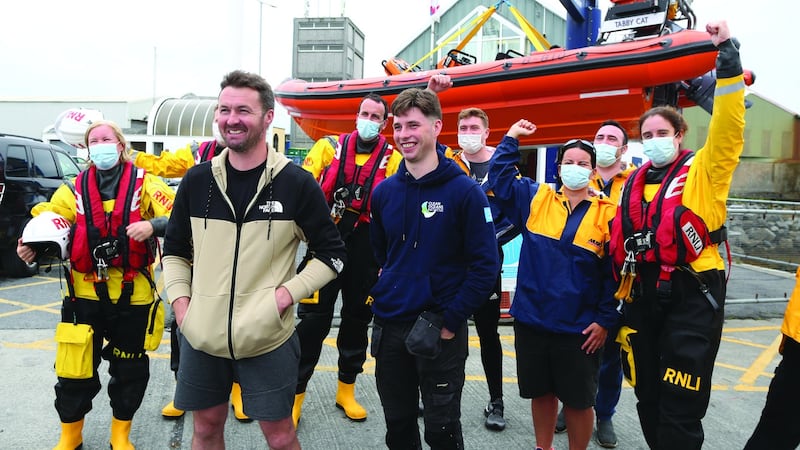
“At that point, we were perfectly safe... I still had my hand on the board,” Sara said later, remembering how distressed her cousin was for her. “If they had come that far, there was no way they were going to stop that from saving us.”
The two men were hauling the paddleboards on to the deck, when Ellen noticed the paddles were drifting off. “They had to just literally pull me away “cause I was going to jump in off the boat and get the paddles,” Ellen said. “And they put oilskins on us and sat us down at the top of the boat and put jackets over us and jumpers... I was like ‘Oh my God, thank you so much, we’ve actually been out here all night... and there’s no one looking for us’.
“The two of them were exhausted. I wouldn’t say they had much left in them,” Morgan said. “With every last bit of energy they showed just how grateful they were for us to be there.”
He reckoned they were already hypothermic and in shock. “We gave them blankets and water and tried to keep the heat in the wheelhouse,” he said.
As they were wrapped in every spare bit of clothing on board, Ellen remembered Morgan suggesting she put her arms up her jumper sleeves for extra heat.
“It was almost like a shutdown at that point,” Sara said. “My body just knew, okay, you’re safe, you can relax now, you’re fine, you don’t need to be so alert. When you are out there you are thinking that all of these people are out there looking, and you have it in your head that if they do find you, you are going to be in some sort of trouble... the stress and everything that you cause people... but they were just so kind, the instant we were on the boat just feeling so safe.”
Before Sara curled up and put her head on her knees in case she might burst into tears, Patrick caught a look in her eyes that he believes he will never forget. As he set course north for Inis Oírr pier, he contacted his brother Ciarán. At the lifeboat station, there was one mighty sigh of absolute relief.
NO TIP REQUIRED
"Air-Sea Rescue Helicopters go to aid of French trawler" read the Irish Times headline over a report from Christmas Eve, 1963 recording the details of the "newly formed" State air-sea rescue service's first mission. "The helicopter landed at Renmore barracks, Galway, and will fly back to Baldonnel today," the report concluded. "It can fly on ordinary motor car petrol, but it has not the same range with this type of fuel as it would have with the proper grade."
In fact, the helicopter had to be given a special engine check on its return to Baldonnel. And, as Capt Chris Carey – one of the first four Air Corps search and rescue pilots – recalled, there had to be "a bit of a rethink" after the Emerance mission. "The Alouette was far better than the RAF's counterpart at the time, but it was still a single-engine aircraft," Carey explained. "I suppose in a sense we were all writing the operations manual. It probably helped that we used to whirl miraculous medals up into that engine from time to time!"
Hardly a month had passed before the young search and rescue crew were back out on the west coast again. Both McMahon and Kelly were on duty when the call came through that a pregnant woman was about to give birth on Inishturk Island in Co Mayo. Would the helicopter be able to fly her to hospital in Castlebar?
McMahon, Kelly and Peter Sheeran weren't quite sure what was ahead of them as they flew northwest from Baldonnel to refuel at Castlebar before flying on out to the island. Effectively this was their first air-ambulance mission and they were still training. If the woman gave birth during the flight, would they be able to cope? They had a sense that they were invincible, O'Connor remembered. "We would have gone anywhere, done anything, and that was simply because we didn't have the experience to say 'no'."
The Alouette landed near the pier. There was no sign of anyone. They had been told that Mrs Flaherty would be there waiting for them. They climbed out of the aircraft. A very heavily pregnant woman was carrying two enormous suitcases towards the pier. McMahon couldn’t believe his eyes. Her husband, smoking a pipe, was walking empty-handed several steps behind her.
The couple climbed on board and the suitcases were heaved in beside them; if Mrs Flaherty was in the advanced stages of labour, the pilot didn’t remember her displaying much distress.
“We had to ask them to wear life jackets, but we couldn’t get it on Mrs Flaherty due to her condition,” he recalled. The flight to Castlebar hospital took about 45 minutes, and there was at least one press camera present and several medical staff when the Alouette landed. As Mrs Flaherty alighted, she turned to the pilot and handed him a £1 note.
“It took me a minute or two to realise that this was a tip and I couldn’t accept it; certainly not when there were cameras there,” McMahon said. “She wouldn’t take it back. She was insistent, and so I had to put it back into her handbag myself. Unfortunately, that’s what the camera caught – me with my hand in her purse!”
Search and Rescue – True Stories of Irish Air-Sea Rescues and the Loss of R116, by Lorna Siggins, is just published by Merrion Press

















